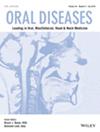Oral squamous cell carcinoma identification by FTIR spectroscopy of oral biofluids
IF 2.9
3区 医学
Q1 DENTISTRY, ORAL SURGERY & MEDICINE
引用次数: 0
Abstract
ObjectivesThis case study evaluated the efficacy of mid‐infrared spectroscopy on the identification of oral squamous cell carcinoma, following the assessment of unstimulated whole saliva.Study Design and MethodsThe trial follows a matched case–control design. Saliva samples were characterized through mid‐infrared spectroscopy, and chemometric tools were applied to distinguish between case and control participants, further identifying the spectral regions that played a pivotal role in the successful identification of oral squamous cell carcinoma.ResultsMid‐infrared spectroscopy was capable to discriminate between cancer patients and matched controls with 100% of correct predictions. Additionally, the spectral regions mostly contributing to the successful prediction were identified and found to be potentially associated with significant molecular changes crucial to the carcinogenic process.ConclusionThe application of mid‐infrared spectroscopy in saliva analysis may be regarded as an innovative, noninvasive, low cost, and sensitive technique contributing to the identification of oral squamous cell carcionma.通过口腔生物流体的傅立叶变换红外光谱鉴定口腔鳞状细胞癌
研究设计与方法该试验采用匹配病例对照设计。通过中红外光谱对唾液样本进行特征描述,并应用化学计量学工具区分病例和对照参与者,进一步确定在成功识别口腔鳞状细胞癌中起关键作用的光谱区域。结论在唾液分析中应用中红外光谱可被视为一种创新、无创、低成本和灵敏的技术,有助于识别口腔鳞状细胞癌。
本文章由计算机程序翻译,如有差异,请以英文原文为准。
求助全文
约1分钟内获得全文
求助全文
来源期刊

Oral diseases
医学-牙科与口腔外科
CiteScore
7.60
自引率
5.30%
发文量
325
审稿时长
4-8 weeks
期刊介绍:
Oral Diseases is a multidisciplinary and international journal with a focus on head and neck disorders, edited by leaders in the field, Professor Giovanni Lodi (Editor-in-Chief, Milan, Italy), Professor Stefano Petti (Deputy Editor, Rome, Italy) and Associate Professor Gulshan Sunavala-Dossabhoy (Deputy Editor, Shreveport, LA, USA). The journal is pre-eminent in oral medicine. Oral Diseases specifically strives to link often-isolated areas of dentistry and medicine through broad-based scholarship that includes well-designed and controlled clinical research, analytical epidemiology, and the translation of basic science in pre-clinical studies. The journal typically publishes articles relevant to many related medical specialties including especially dermatology, gastroenterology, hematology, immunology, infectious diseases, neuropsychiatry, oncology and otolaryngology. The essential requirement is that all submitted research is hypothesis-driven, with significant positive and negative results both welcomed. Equal publication emphasis is placed on etiology, pathogenesis, diagnosis, prevention and treatment.
 求助内容:
求助内容: 应助结果提醒方式:
应助结果提醒方式:


